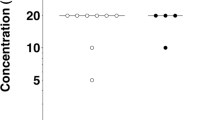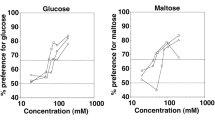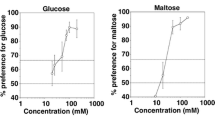Abstract
Gustatory responsiveness of six adult squirrel monkeys, four spider monkeys, and five pigtail macaques to six bitter tastants was assessed in two-bottle preference tests of brief duration (2 min). Animals were given the choice between a 30-mM sucrose solution and defined concentrations of a bitter tastant dissolved in a 30-mM sucrose solution. With this procedure, Saimiri sciureus, Ateles geoffroyi, and Macaca nemestrina were found to significantly discriminate concentrations as low as 0.2, 0.05, and 0.1 mM quinine hydrochloride; 1, 1, and 0.05 mM caffeine; 20, 5, and 1 mM naringin; 5, 2, and 1 mM salicin; 0.01, 0.001, and 0.02 mM sucrose octaacetate; and 0.05, 0.01, and 0.5 mM denatonium benzoate, from the alternative stimulus. With the exception of naringin in the pigtail macaques, all three species rejected all suprathreshold concentrations of all bitter tastants tested. The spider monkeys and the pigtail macaques displayed the lowest taste avoidance thresholds with three of the six tastants each; in contrast, the squirrel monkeys displayed the highest taste avoidance thresholds with four of the six tastants. The across-tastant patterns of taste avoidance thresholds were identical in spider monkeys and squirrel monkeys; both species displayed the following order of sensitivity: sucrose octaacetate > denatonium benzoate > quinine hydrochloride > caffeine > salicin > naringin. All three primate species were more sensitive to the two artificial tastants (sucrose octaacetate and denatonium benzoate) compared to the four naturally occurring tastants. However, the concentrations detected by all three primate species with the four naturally occurring tastants are well below those reported in plants or arthropods consumed by these species suggesting that they may use bitterness as a criterion for food selection.



Similar content being viewed by others
References
Aspen, J., Gatch, M.B., and Woods, J.H. 1999. Training and characterization of a quinine taste discrimination in rhesus monkeys. Psychopharmacology 141:251–257.
Behrens, M. and Meyerhof, W. 2006. Bitter taste receptors and human bitter taste perception. Cell. Mol. Life Sci. 63:1501–1509.
Belitz, H.D. and Wiester, H. 1985. Bitter compounds: occurrence and structure–activity relationships. Food Rev. Int. 1:271–354.
Belovsky, G.E. and Schmitz, O.J. 1991. Mammalian herbivore optimal foraging and the role of plant defenses, pp. 1–28, in R.T. Palo and C.T. Robbins (eds.). Plant Chemical Defence and Mammalian Herbivory. CRC Press, Cincinnati.
Bloom, J.C., Rogers, J.G., and Maller, O. 1973. Taste responses of the North American porcupine (Erethizon dorsatum). Physiol. Behav. 11:95–98.
Boughter, J.D. and Whitney, G. 1993a. Human taste thresholds for sucrose octaacetate. Chem. Senses 18:445–448.
Boughter, J.D. and Whitney, G. 1993b. Human taste thresholds for sucrose octaacetate. Chem. Senses 18:445–448.
Boughter, J.D., St. John, S.J., Noel, D.T., Ndubuizu, O., and Smith, D.V. 2002. A brief-access test for bitter taste in mice. Chem. Senses 27:133–142.
Boughter, J.D., Raghow, S., Nelson, T.M., and Munger, S.D. 2005. Inbred mouse strains C57BL/6 J and DBA/2 J vary in sensitivity to a subset of bitter stimuli. BMC Genet. 6:36.
Brasser, S.M., Mozhui, K., and Smith, D.V. 2005. Differential covariation in taste responsiveness to bitter stimuli in rats. Chem. Senses 30:793–799.
Bufe, B., Hofmann, T., Krautwurst, D., Raguse, J.D., and Meyerhof, W. 2002. The human TAS2R16 receptor mediates bitter taste in response to beta-glucopyranosides. Nat. Genet. 32:397–401.
Caldecott, J.O. 1986. An Ecological and Behavioural Study of the Pig-Tailed Macaque. Contributions to Primatology, vol. 21. Karger, Basel.
Carpenter, J.A. 1956. Species differences in taste preferences. J. Comp. Physiol. Psychol. 49:139–144.
Chrzanowski, Z. 1965. Die Auswahlschwelle, die Abweisschwelle und die Geschmackstoleranz von Wasserlösungen des Chininhydrochlorids einiger Arten von Insektenfressern und Nagetieren. Acta. Biol. Exp. 25:37–58.
Cicala, G.A. and McMichael, J.S. 1964. Quinine aversion thresholds in rats as a function of age and psychophysical procedure. Can. J. Psychol. 18:28–35.
Crawford, J.C. and Church, D.C. 1971. Response of black-tailed deer to various chemical taste stimuli. J. Wildl. Manage. 35:210–215.
Drewnowksi, A., Henderson, S.A., and Shore, A.B. 1997. Taste responses to naringin, a flavonoid, and the acceptance of grapefruit juice are related to genetic sensitivity to 6-n-propylthiouracil. Am. J. Clin. Nutr. 66:391–397.
DuBois, G.E. 2007. Chemistry of gustatory stimuli, pp. 27–74, in A. Basaum (ed.). The Senses: A Comprehensive Reference, vol 4. Academic, New York.
Eisner, T., Eisner, M., and Siegler, M. 2005. Secret Weapons: Defenses of Insects, Spiders, Scorpions, and Other Many-Legged Creatures. Harvard University Press, Cambridge.
Frank, M.E., Bouverat, B.P., MacKinnon, B.I., and Hettinger, T.P. 2004. The distinctiveness of ionic and nonionic bitter stimuli. Physiol. Behav. 80:421–431.
Ganchrow, J.R. 1977. Consummatory responses to taste stimuli in the hedgehog (Erinaceus europaeus). Physiol. Behav. 18:447–453.
Gannon, K.S., and Whitney, G. 1989. Sucrose octaacetate tasting in a heterogeneous population of CFW mice. Behav. Genet. 19:417–431.
Garcia, J. and Hankins, W.G. 1975. The evolution of bitter and the acquisition of toxiphobia, pp. 39–45, in D.A. Denton and J.P. Coghlan (eds.). Olfaction and Taste V. Academic, New York.
Glaser, D. 1986. Geschmacksforschung bei Primaten. Vjschr. Naturforsch. Ges. Zurich 131:92–110.
Glaser, D., Wanner, M., Tinti, J.M., and Nofre, C. 2001. Pig responses to taste stimuli, pp. 423–431, in A. Marchlewska-Koj (ed.). Chemical Signals in Vertebrates 9. Kluwer, New York.
Glendinning, J.I. 1993. Preference and aversion for deterrent chemicals in two species of Peromyscus mouse. Physiol. Behav. 54:141–150.
Glendinning, J.I. 1994. Is the bitter rejection response always adaptive? Physiol. Behav. 56:1217–1227.
Glendinning, J.I., Gresack, J., and Spector, A.C. 2002. A high-throughput screening procedure for identifying mice with aberrant taste and oromotor function. Chem. Senses 27:461–474.
Goatcher, W.D., and Church, D.C. 1970a. Taste responses in ruminants. II. Reactions of sheep to acids, quinine, urea and sodium hydroxide. J. Anim. Sci. 30:784–790.
Goatcher, W.D., and Church, D.C. 1970b. Taste responses in ruminants. IV. Reactions of pygmy goats, normal goats, sheep and cattle to acetic acid and quinine hydrochloride. J. Anim. Sci. 31:373–382.
Gonzalez-Zamora, A., Arroyo-Rodriguez, V., Chaves, O.M., Sanchez-Lopez, S., Stoner, K.E., and Riba-Hernandez, P. 2009. Diet of spider monkeys (Ateles geoffroyi) in Mesoamerica: current knowledge and future directions. Am. J. Primatol. 71:8–20.
Harder, D.B., Whitney, G., Frye, P., Smith, J.C., and Rashotte, M.E. 1984. Strain differences among mice in taste psychophysics of sucrose octaacetate. Chem. Senses 9:311–323.
Hellekant, G. and Ninomiya, Y. 1994. Bitter taste in single chorda tympani fibers from chimpanzee. Physiol. Behav. 56:1185–1188.
Hladik, C.M., Pasquet, P., and Simmen, B. 2002. New perspectives on taste and primate evolution: the dichotomy in gustatory coding for perception of beneficent versus noxious substances as supported by correlations among human thresholds. Am. J. Phys. Anthropol. 117:342–348.
Iaconelli, S. and Simmen, B. 2002. Taste thresholds and suprathreshold responses to tannin-rich plant extracts and quinine in a primate species (Microcebus murinus). J. Chem. Ecol. 28:2315–2326.
Iason, G.R. and Villalba, J.J. 2006. Behavioral strategies of mammal herbivores against plant secondary metabolites: the avoidance–tolerance continuum. J. Chem. Ecol. 32:1115–1132.
Jacobs, W.W. 1978. Taste responses in wild and domestic guinea pigs. Physiol. Behav. 20:579–588.
Kare, M. 1971. Comparative study of taste, pp. 278–292, in L.M. Beidler (ed.). Handbook of Sensory Physiology, vol. IV, Part 2. Springer, Berlin.
Koh, S.D., and Teitelbaum, P. 1961. Absolute behavioral taste thresholds in the rat. J. Comp. Physiol. Psychol. 54:223–229.
Laska, M. 1994. Taste difference thresholds for sucrose in squirrel monkeys (Saimiri sciureus). Folia Primatol. 63:144–148.
Laska, M. 1996. Taste preference thresholds for food-associated sugars in the squirrel monkey, Saimiri sciureus. Primates 37:93–97.
Laska, M. 1997. Taste preferences for five food-associated sugars in the squirrel monkey (Saimiri sciureus). J. Chem. Ecol. 23:659–672.
Laska, M. 1999. Taste responsiveness to food-associated acids in the squirrel monkey (Saimiri sciureus). J. Chem. Ecol. 25:1623–1632.
Laska, M. 2000. Gustatory responsiveness to food-associated sugars and acids in pigtail macaques Macaca nemestrina. Physiol. Behav. 70:495–504.
Laska, M. and Hernandez Salazar, L.T. 2004. Gustatory responsiveness to monosodium glutamate and sodium chloride in four species of nonhuman primates. J. Exp. Zool. 301A:898–905.
Laska, M., Carrera Sanchez, E., Rodriguez Rivera, J.A., and Rodriguez Luna, E. 1996. Gustatory thresholds for food-associated sugars in the spider monkey (Ateles geoffroyi). Am. J. Primatol. 39:189–193.
Laska, M., Carrera Sanchez, E., and Rodriguez Luna, E. 1998. Relative taste preferences for food-associated sugars in the spider monkey (Ateles geoffroyi). Primates 39:91–96.
Laska, M., Scheuber, H.P., Carrera Sanchez, E., and Rodriguez Luna, E. 1999. Taste difference thresholds for sucrose in two species of nonhuman primates. Am. J. Primatol. 48:153–160.
Laska, M., Hernandez Salazar, L.T., and Rodriguez Luna, E. 2000. Food preferences and nutrient composition in captive spider monkeys, Ateles geoffroyi. Int. J. Primatol. 21:671–683.
Laska, M., Hernandez Salazar, L.T., Rodriguez Luna, E., and Hudson, R. 2000. Gustatory responsiveness to food-associated acids in the spider monkey (Ateles geoffroyi). Primates 41:213–221.
Laska, M., Kohlmann, S., Scheuber, H.P., Hernandez Salazar, L.T., and Rodriguez Luna, E. 2001. Gustatory responsiveness to polycose in four species of nonhuman primates. J. Chem. Ecol. 27:1997–2011.
Laska, M., Persson Suorra, J., Rivas Bautista, R.M., and Hernandez Salazar, L.T. 2008. Taste difference thresholds for monosodium glutamate and sodium chloride in pigtail macaques (Macaca nemestrina) and spider monkeys (Ateles geoffroyi). Am. J. Primatol. 70:839–847.
Lima, E.M. and Ferrari, S.F. 2003. Diet of a free-ranging group of squirrel monkeys (Saimiri sciureus) in eastern Brazilian Amazonia. Folia Primatol. 74:150–158.
Nagy, S. and Shaw, P.E. 1980. Tropical and Subtropical Fruits: Composition, Nutritive Values, Properties and Uses. AVI, Westport.
Nelson, S.L. and Sanregret, J.D. 1997. Response of pigs to bitter-tasting compounds. Chem. Senses 22:129–132.
Nofre, C., Tinti, J.M., and Glaser, D. 1996. Evolution of the sweetness receptor in primates. II. Gustatory responses of non-human primates to nine compounds known to be sweet in man. Chem. Senses 21:747–762.
Pfaffmann, C. 1977. Biological and behavioral substrates of the sweet tooth, pp. 3–24, in J.M. Weiffenbach (ed.). Taste and Development. The Genesis of Sweet Preference. US Government Printing Office, Washington DC.
Pritchard, T.C., Reilly, S., Hamilton, R.B., and Norgren, R. 1994. Taste preference of Old World monkeys: I. A single-bottle preference test. Physiol. Behav. 55:477–481.
Pritchard, T.C., Bowen, J.A., and Reilly, S. 1995. Taste thresholds in non-human primates. Chem. Senses 20:760.
Randall, R.P., Schurg, W.A., and Church D.C. 1978. Response of horses to sweet, salty, sour, and bitter solutions. J. Anim. Sci. 47:51–55.
Richter, C.P. and Campbell, K.H. 1940. Taste thresholds and taste preferences of rats for five common sugars. J. Nutr. 20:31–46.
Rouseff, R.L. 1990. Bitterness in Foods and Beverages. Elsevier, New York.
Schiffman, S.S. 2000. Taste quality and neural coding: implications from psychophysics and neurophysiology. Physiol. Behav. 69:147–159.
Schiffman, S.S., Gatlin, L.A., Sattely-Miller, E.A., Graham, B.G., Heiman, S.A., Stagner, W.C., and Erickson, R.P. 1994. The effect of sweeteners on bitter taste in young and elderly subjects. Brain Res. Bull. 35:189–204.
Scott, T.R., Giza, B.K., and Yan, J. 1998. Electrophysiological responses to bitter stimuli in primate cortex. Ann. N. Y. Acad. Sci. 855:498–501.
Scott, T.R., Giza, B.K., and Yan, J.Q. 1999. Gustatory neural coding in the cortex of the alert cynomolgus monkey: the quality of bitterness. J. Neurophysiol. 81:60–71.
Siegel, S. and Castellan, N.J. 1988. Nonparametric statistics for the behavioral sciences. McGraw Hill, New York.
Simmen, B. and Hladik, C.M. 1998. Sweet and bitter taste discrimination in primates: scaling effects across species. Folia Primatol. 69:129–138.
Smagghe, K. and Louis-Sylvestre, J. 1998. Influence of PROP-sensitivity on taste perceptions and hedonics in French women. Appetite 30:325–339.
Soldo, T. and Hofmann, T. 2005. Application of hydrophilic interaction liquid chromatography/comparative taste dilution analysis. J. Agric. Food Chem. 53:9165–9171.
Souci, S.W., Fachmann, W., and Kraut, H. 1989. Food Composition and Nutrition Tables. Wissenschaftliche Verlagsgesellschaft, Stuttgart.
Spector, A.C. 2000. Linking gustatory neurobiology to behavior in vertebrates. Neurosci. Biobehav. Rev. 24:391–416.
Stevens, J.C. 1996. Detection of tastes in mixture with other tastes: issues of masking and aging. Chem. Senses 21:211–221.
Stewart, R.B., Russell, R.N., Lumeng, L., Li, T.K., and Murphy, J.M. 1994. Consumption of sweet, salty, sour, and bitter solutions by selectively bred alcohol-preferring and alcohol-nonpreferring lines of rats. Alcoholism Clin. Exp. Res. 18:375–381.
Tordoff, M.G., Alarcon, L.K., and Lawler, M.P. 2008. Preferences of 14 rat strains for 17 taste compounds. Physiol. Behav. 95:308–332.
Whitney, G. and Harder, D.B. 1994. Genetics of bitter perception in mice. Physiol. Behav. 56:1141–1147.
Young, P.T., Burright, R.G., and Tromater, L.J. 1963. Preferences of the white rat for solutions of sucrose and quinine hydrochloride. Am. J. Psychol. 76:205–217.
Acknowledgments
Financial support by CONACYT Mexico to Laura Teresa Hernandez Salazar (J-51435-IV) is gratefully acknowledged. Special thanks to Alexander A. Bachmanov of the Monell Chemical Senses Center for his willingness to share unpublished data with us.
Author information
Authors and Affiliations
Corresponding author
Rights and permissions
About this article
Cite this article
Laska, M., Rivas Bautista, R.M. & Hernandez Salazar, L.T. Gustatory Responsiveness to Six Bitter Tastants in Three Species of Nonhuman Primates. J Chem Ecol 35, 560–571 (2009). https://doi.org/10.1007/s10886-009-9630-8
Received:
Revised:
Accepted:
Published:
Issue Date:
DOI: https://doi.org/10.1007/s10886-009-9630-8




